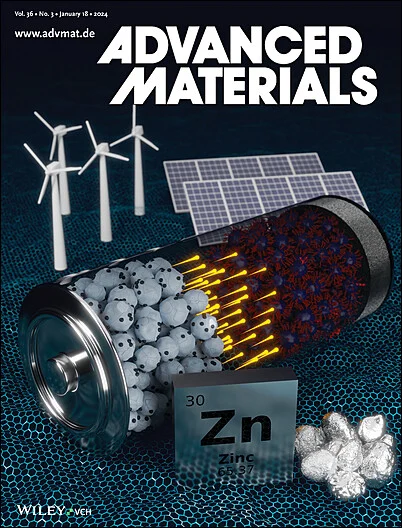基于机器学习的高熵钠离子阴极设计与全链研究。
IF 26.8
1区 材料科学
Q1 CHEMISTRY, MULTIDISCIPLINARY
引用次数: 0
摘要
如何熟练、准确地探索材料广阔的组成空间,加速开发性能优异的新材料,特别是结构复杂的高熵氧化物(HEOs),一直是材料科学面临的挑战。为了解决这个问题,提出了一种最先进的混合流机器学习(HFML)框架,该框架结合了集成学习,无监督学习和贝叶斯优化,能够有效地发现隐藏模式并全面探索组件空间。基于所提出的HFML,从200多万个钠离子电池候选材料中筛选出了一种新的HEO正极材料(Na0.95Li0.06Ni0.25Cu0.05Fe0.1Co0.05Mn0.44Ti0.05O2),该材料具有良好的循环稳定性(1200次循环后容量保持率为83.6%)和高倍率性能(10℃下110 mAh g-1, 20℃下96 mAh g-1)。确定了影响结构稳定性的关键因素,包括s嵌段金属离子、Cu2+、高价d0和d10金属离子,并通过电化学测试和x射线衍射(XRD)原位测量进行了验证。此外,还实现了中试规模生产,基于该阴极的2 Ah袋电池在600次循环后的容量保持率为95.0%。完成了从人工智能材料预测、创造、性能验证到中试应用(量产、袋装钠电池)的全链条研究。本文章由计算机程序翻译,如有差异,请以英文原文为准。
Machine Learning for Design and Full Chain Research of High-Entropy Na-Ion Cathodes.
How to proficiently and accurately explore the vast compositional space of materials and accelerate the development of new materials with outstanding properties, especially structurally complex high-entropy oxides (HEOs), remains a challenge in materials science. To address this, a state-of-the-art hybrid flow machine learning (HFML) framework is proposed, which combines ensemble learning, unsupervised learning, and Bayesian optimization, enabling efficient discovery of hidden patterns and comprehensive exploration of the component space. Based on the proposed HFML, a new HEO cathode material is screened out from over 2 million candidates for sodium-ion batteries (Na0.95Li0.06Ni0.25Cu0.05Fe0.1Co0.05Mn0.44Ti0.05O2), which shows excellent cycling stability (capacity retention of 83.6% after 1200 cycles) and high-rate performance (110 mAh g-1 at 10 C, and 96 mAh g-1 at 20 C). Key factors affecting structural stability are identified, including s-block metal ions, Cu2+, high-valence d0 and d10 metal ions, and are verified by electrochemical tests and in situ X-ray diffraction (XRD) measurements. Additionally, pilot-scale production is achieved, and 2 Ah pouch cells based on this cathode demonstrate 95.0% capacity retention after 600 cycles. This work accomplishes the full chain study from artificial intelligence material prediction, creation, and performance verification to pilot application (mass production and pouch sodium batteries).
求助全文
通过发布文献求助,成功后即可免费获取论文全文。
去求助
来源期刊

Advanced Materials
工程技术-材料科学:综合
CiteScore
43.00
自引率
4.10%
发文量
2182
审稿时长
2 months
期刊介绍:
Advanced Materials, one of the world's most prestigious journals and the foundation of the Advanced portfolio, is the home of choice for best-in-class materials science for more than 30 years. Following this fast-growing and interdisciplinary field, we are considering and publishing the most important discoveries on any and all materials from materials scientists, chemists, physicists, engineers as well as health and life scientists and bringing you the latest results and trends in modern materials-related research every week.
 求助内容:
求助内容: 应助结果提醒方式:
应助结果提醒方式:


